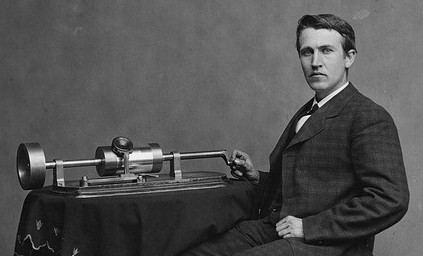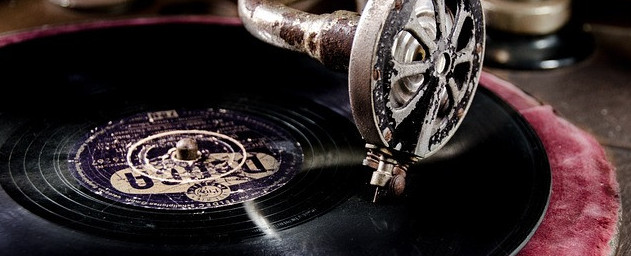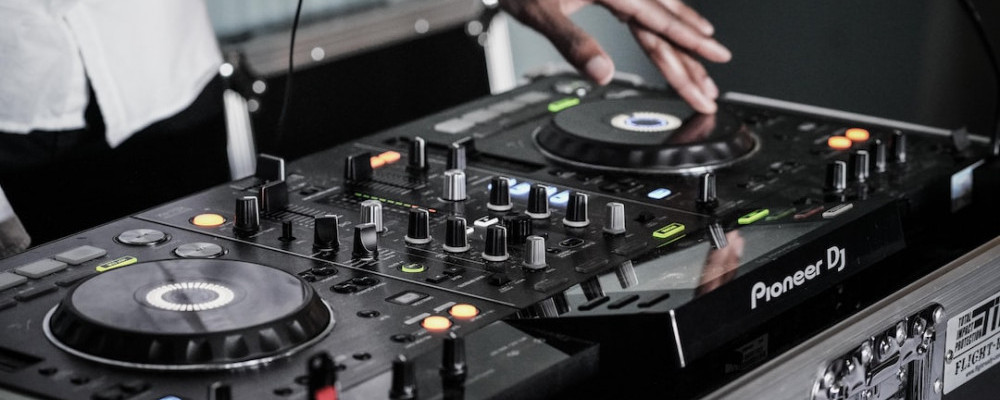As you may expect, two of the greatest inventors/engineers of the Victorian era, Thomas Alva Edison and Alexander Graham Bell, had a hand in the early days of record player or perhaps more accurately, the development of sound recording.

The earliest days of sound recording
However, perhaps the first figure in the history of record players, the first person to record sound, was a Frenchman of Scottish descent by the name of Edouard-Léon Scott de Martinville. Scott’s machine, known as the phonautograph, recorded, or rather, transcribed sounds as undulations on smoke-blackened paper or glass. It could not, though, be played back and was never intended for that purpose.
Another Frenchman, Charles Cros, realised in 1877 that in fact, a phonautograph could be converted back into sound by etching the tracing onto a metal surface, thus creating a playable groove.
However, Cros’s idea was relegated almost to a footnote in recording history by Edison’s 1877 invention of the phonograph. This cardboard cylinder covered in tinfoil recorded sound that could be played back.
The mechanics of recording sound
To record, a stylus or needle would etch a groove etched into the tinfoil as the cylinder rotated. For subsequent playback, another stylus would follow the groove thus created and its motions would be converted into sound.
Bell improved Edison’s early design by using wax as the recording/playback medium. This had the advantage of not tearing as the tinfoil was prone to do.
Emile Berliner’s flat records
However, nobody so far had struck on the idea of having sounds recorded and therefore played on a flat disc – like a modern-day record, rather than a cylinder. In 1887, German American, Emile Berliner was awarded a patent for his gramophone, essentially a form of the phonautograph. Tracing a sound-modulated spiral line through a thin black coating on a glass disc, Cros’s photoengraving method was then used to produce a metal disc with a playable groove.

By 1892, Berliner had begun to offer flat disc records and gramophones to the public, and for two decades, his horizontal system competed with the more common Edison/Bell cylindrical system.
Format wars, Victorian style
Throughout the 1890s, and in a foreshadowing of later format wars such as the VHS versus Betamax, the better sound quality of the cylindrical system was offset by the more robust manufacturing process associated with Berliner’s system. The drawback of Berliner’s system was the sound quality.
The discs could be stamped, and the zinc negative or mother disc could be shipped globally. This advantage was not available to cylinders until Edison’s introduction of his gold moulding process in the early part of the new century.
Berliner’s original discs were five inches or 127 mm in diameter, made from hard rubber and recorded on one side only. By 1895, they had expanded to seven inches (178 mm) as Berliner moved towards the use of shellac.
Improvements to Berliner’s sound quality
Work by Eldridge R. Johnson eventually meant that the sound quality of Berliner’s system became a match for the cylinder system – Johnson also invented a wind-up spring motor which improved the gramophone still further.
Johnson and Berliner’s relationship was made closer in the very early years of the new century when fall out from Berliner’s legal battle with Frank Seaman virtually put paid to Berliner’s gramophone business in the US.
Instead, using Berliner’s patents, Johnson founded the Consolidated Talking Machine Company of Philadelphia, located at the same address as the Berliner Gramophone Company. This soon became the Victor Talking Machine Company in deference, it is believed, to Johnson and Berliner’s final legal victory.
Record player technology moves into the twentieth century
Moving into the twentieth century, it wasn’t long until the flat, gramophone record would out muscle cylinder recordings. Consider this, in 1893, Berliner sold a thousand gramophone record players and around 25 000 shellac records. By 1903, Berliner/Johnson sold almost two million records. By 1912 cylinders were effectively superseded, although the Edison phonographs were in constant manufacture until 1929.
By the latter part of the roaring twenties, electricity-powered record players were playing the latest hip jazz tracks. Fly-wheel friction discs, like those in the clutch of a car were used to keep record speeds even.
Also at this time, radio was booming and consequently, was hitting the record market hard. As a result, combination home systems became popular. As well as a turntable, these included inbuilt amplification (preamp and amp), speaker units and radio. These were record players. It seems a little like splitting hairs, but the distinction is important.
The acceleration of developments in record player technology
Further hardware developments were held up by the Great Depression and latterly WWII. Attempts were made, in the early 1930s by RCA to upgrade their record and therefore record player technology with their abortive 33⅓ rpm long play records and the more successful small, but basic turntable, the Duo Jr, which was designed to be plugged into and therefore utilise the amplifier and speakers of radio sets.
However, perhaps the last truly ground-breaking innovations in ‘vinyl’ were released in 1948 and 1949 with Columbia’s 33⅓ rpm 10- or 12-inch micro-grooved LP records followed by RCA’s 45 rpm 7 inch single. Record players on which to play these new-fangled records were released by Columbia and RCA concurrently with the records, and other manufacturers soon followed suit and record players that were switchable between 33⅓, 45 and 78 rpm became ubiquitous.
The advent of the turntable
The separate turntable – without built-in speakers or an amplifier; but with a stylus, cartridge, and a tone arm – was invented in 1930, but it was not until the 1960s that it became popular. First with hobbyists, known as audiophiles, but later with the wider population.
Manufacturers such as Garrard (now owned by Cadence Audio of India) or Thorens of Germany made the most popular turntables with Grado Labs phono cartridges.
Stereo turntables
Around the turn of the sixties, stereo recordings became available, building upon work done in the 1930s by British sound engineer Alan Dower Blumlein. The likes of Columbia and RCA sold stereo records and record players, which used a stylus that moved vertically as well as laterally, delivering signals from the left and the right.
At the same time, the term high-fidelity or hi-fi was first introduced to describe sound quality. This was in part due to turntables beginning to be belt-driven, rather than using a motor-driven rubber wheel system. Using a belt in this way, meant that vibrations from the motor were absorbed by it, thus improving sound quality. By the early seventies, direct drives had been introduced, although their impact on sound quality was an issue for some.
The impact of music on turntable sound quality
In 1967, in response to The Beach Boys’ Pet Sounds, The Beatles released Sgt Pepper’s Lonely Hearts Club Band which fuelled demand for even better turntables. Turntables such as the Dual 1009 became popular – although this had a record changer which, for dyed-in-the-wool audiophiles, was a no-no due to the perceived risk of damage because of stacking vinyl.
Into the seventies and onto Japan
By this stage, turntables from Japanese manufacturers began to dominate the market and they were often given English-sounding names – for example, Technics, a brand name of Panasonic (formerly the Matsushita Company). Technics (in the guise of Shuichi Obata) was the inventor of the direct drive turntable with the evocatively named SP-10 released to the market in 1971.
Its successor, the SL-1100, was rated very highly and, due to its high durability, became a staple of the nascent hip-hop movement. In an exciting twist, the turntable was now being used as a musical instrument. For example, it was used by DJ Kool Herc as part of his sound system after he emigrated from Jamaica to the Bronx in the late sixties.

Other hip-hop pioneers such as Afrika Bambaataa and Grandmaster Flash both favoured Technics turntables. The turntable was no longer just a means to play pre-recorded music.
What now for turntables?
With the lull of vinyl sales from the late eighties, Technics was retired as a brand by Panasonic. Other turntable manufacturers ceased production too. However, vinyl never quite went away. When vinyl sales surged, once again overtaking sales of CDs, Technics was relaunched in 2014.
If you have enjoyed this article or have anything you would like to add to the debate, please leave me a comment below.
